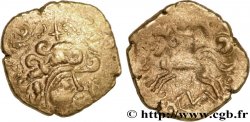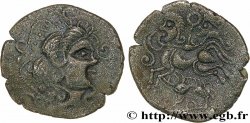v34_1278 - VENETI (Regione di Vannes) Quart de statère d’or DT. 2134 au rameau en cimier
MONNAIES 34 (2008)
Начальная цена : 2 800.00 €
Назначить цену : 4 500.00 €
Цена реализации : 3 106.00 €
Количество ставок : 3
Максимальная предлагаемая цена : 4 125.00 €
Начальная цена : 2 800.00 €
Назначить цену : 4 500.00 €
Цена реализации : 3 106.00 €
Количество ставок : 3
Максимальная предлагаемая цена : 4 125.00 €
Тип Quart de statère d’or DT. 2134 au rameau en cimier
Дата: IIe siècle avant J.-C.
Монетный двор / Город: Vannes (56)
Металл: gold
Диаметр: 12,8 mm
Ориентация осей монеты: 1 h.
Вес: 1,85 g.
Редкость: R3
Комментарии о состоянии
Très belle petite monnaie, avec une frappe très légèrement bouchée au droit, mais avec un revers magnifiquement centré, par rapport à l’étroitesse du flan, et de conservation excellente
Ссылки в каталоге: :
Лицевая сторона
Аверс: легенда: ANÉPIGRAPHE.
Аверс: описание: Tête à droite, les cheveux en grosses mèches ; de la tête partent quatre cordons perlés, terminés chacun par une petite tête, un rameau en guise de cimier au-dessus de la tête, entouré de deux cordons perlés.
Обратная сторона
Реверс: легенда: ANÉPIGRAPHE.
Реверс: Описание: Cheval androcéphale, bridé à droite ; au-dessus, l'aurige tient un lien ondulant relié à un étendard qui flotte devant la tête du cheval ; un personnage ailé sous le cheval.
Комментарий
Cet exemplaire semble être issu des mêmes coins que le quart de la BN, n° 6894, repris pour illustrer le Nouvel Atlas. Les auteurs proposent une branche de gui (?) pour décrire le cimier. Cette rare monnaie appartient à ce groupe varié de quart sans statère unité connu. Au revers, la roue du char est hors flan, comme sur quasiment tous les quarts vénètes !.
This example appears to come from the same dies as the BN quarter, No. 6894, used to illustrate the New Atlas. The authors suggest a mistletoe branch (?) to describe the crest. This rare coin belongs to this varied group of quarters without a known unit stater. On the reverse, the chariot wheel is off-flan, as on almost all Venetian quarters!
This example appears to come from the same dies as the BN quarter, No. 6894, used to illustrate the New Atlas. The authors suggest a mistletoe branch (?) to describe the crest. This rare coin belongs to this varied group of quarters without a known unit stater. On the reverse, the chariot wheel is off-flan, as on almost all Venetian quarters!








 Cообщить об ошибке
Cообщить об ошибке Распечатать страницу
Распечатать страницу Отправить мой выбор
Отправить мой выбор Задать вопрос
Задать вопрос Consign / sell
Consign / sell
 Информация
Информация









